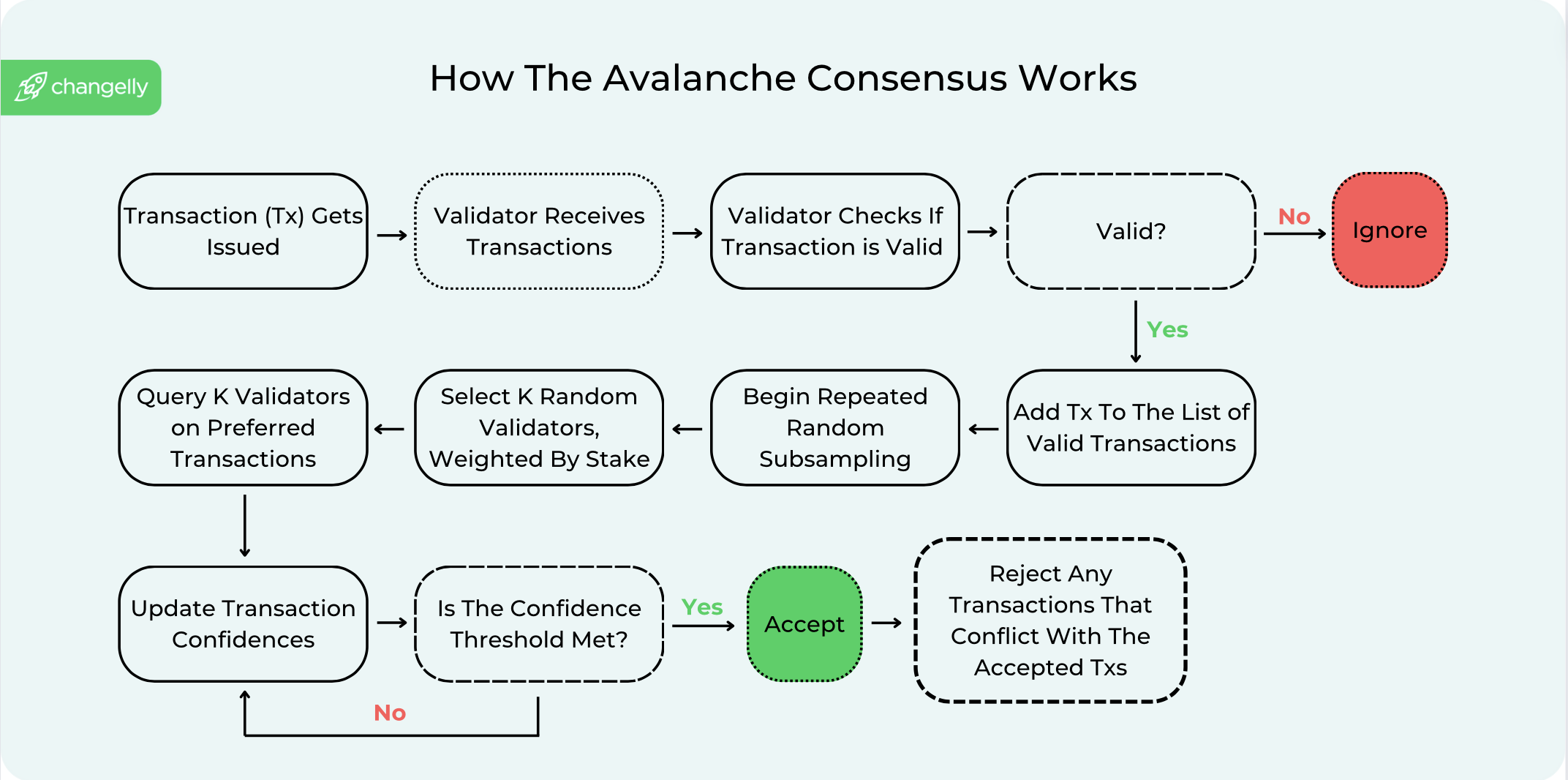There are thousands of different cryptocurrencies on the market, but not many of them offer users really use -or find their place and rise to the top despite direct competition with other top crypto coins and tokens. However, Avalanche is one of such crypto assets. But what is Avax and how does it work? Let’s take a look at one of Ethereum’s most successful competitors.
What is AVAX Crypto?

Avax is the native token of the Avalanche platform, a blockchain network that wants to offer high transit, low latency and unparalleled scalability. Unlike many of its predecessors, Avalanche distinguishes itself with a unique architecture that is designed to resolve some of the most important challenges of the blockchain trilemma: security, scalability and decentralization.
Avalanche positions itself as a direct competitor of Ethereum and tries to tackle some of the scalability and transaction speed problems that the latter have plagued. AVAX serves multiple purposes within the Avalanche ecosystem. It is used to pay transaction costs, secure the network by strike and to act as a basic account unit for multiple block chains within the Avalanche network.
One of the most important characteristics of Avalanche is the consensus mechanism, a new approach that combines the benefits of both classical consensus and nakamoto consensus mechanisms. This facilitates rapid transaction processing (reportedly thousands per second) without this being at the expense of network security. In addition, the Avalanche network supports the creation of subnets, so that in essence adapted, application-specific block chains can be created that can work according to their own rules and still benefit from the safety and interoperability of the most important Avalanche network.
A subnet is a sovereign network that has its own rules guiding its token economy and membership. This set of nodes/validators is responsible for reaching consensus for transactions on one or more block chains.
Who has created Avalanche?
Avalanche was made by a team of researchers, computer scientists and experts in various areas, led by Emin Gün Sirer. Sirer is a well-known figure in computer science and cryptocurrency communities, with a rich background in peer-to-peer systems, distributed computer use and blockchain technology. He is a professor at Cornell University, where his research has extensively focused on the scalability and security aspects of blockchain technologies.
The project originated from a white paper published in 2018, entitled “Snowflake to Avalanche: A Novel Metatable Consensus Protocol Family for Cryptocurrencies.” The article introduced a new family of consensus protocols that promised significant improvements compared to existing blockchain systems. After publication, Sirer founded Ava Labs with Kevin Sekniqi and Maofan “Ted” Yin, Ph.D. candidates from Cornell University, to develop and implement the ideas from the white paper into what would become the Avalanche platform.
How does avalanche work?
Avalanche (AVAX) works on an innovative platform that is designed to tackle the long-standing challenges of blockchain technology: scalability, security and decentralization. In essence, Avalanche introduces a new approach to consensus that enables the network to achieve a remarkable transit and almost immediate finality, making it distinguishing from traditional block chains.
Avalanche’s unique consensus mechanism combines classic consensus and Nakamoto consensus models. In contrast to the proof-of-work (POW) model used by Bitcoin, which depends on a single chain of blocks, Avalanche uses a targeted acyclic graph (day) structure for transactions along multiple chains within its ecosystem. This arrangement enables parallel processing, significantly increasing the capacity and transaction speed of the network.

Avalanche-consensus works on the principles of voices based on subsampling. Instead of demanding that the entire network validates a transaction, it randomly selects a subset of validators to quickly reach a decision. This process repeats itself over different rounds, whereby each round reaches a higher level of trust in the validity of the transaction until it becomes virtually irreversible. With this method, Avalanche can process thousands of transactions per second (TPS), where the finality of the transaction is reached in less than two seconds, a significant improvement compared to networks such as Bitcoin and Ethereum.
Network structure
The Avalanche Network consists of three individual blockchains, each serving a different purpose:
- X-chain (exchange chain): This chain is responsible for creating and trading Avax tokens and other digital assets. It uses the Avalanche consensus mechanism.
- C chain (contract chain): The C-Chain enables the creation of smart contracts and decentralized applications (dApps). It is compatible with the Ethereum Virtual Machine (EVM), making it easy for developers to migrate their Ethereum projects to Avalanche.
- P chain (platform chain): This chain coordinates validators, follows active subnets and makes the creation of new adapted subnets possible. It uses the Snowman consensus protocol, a variant of Avalanche-consensus that is optimized for smart contracts and simple transaction sequences.
The role of Avax
Avax is a native cryptocurrency of the Avalanche network; It plays various crucial roles within its ecosystem. First, it is used to pay transaction costs on the network, incentivizing validators to process transactions. Second, Avax is used to expand, whereby validators lock up a certain number of tokens as collateral to participate in the consensus process, so that the network is protected. The staking mechanism also provides a degree of decentralization, as anyone with enough AVAX can become a validator. Third, it is a requirement to participate in Avalanche network management: Only AVAX owners can vote for changes in the ecosystem. Last but not least is one of the other important usage scenarios to offer a basic account unit between different subnets on Avalanche.
Token has a maximum range of 720 million, with mechanisms to keep inflation under control and to encourage scarcity, which influences its value proposition.
Avalanche versus ethereum
Avalanche and Ethereum are both prominent names in the blockchain industry, each serving as a fundamental blockchain platform with different characteristics and yet some fundamental similarities. Ethereum, the first blockchain ecosystem that supports decentralized applications (Dapps) and smart contracts, has established itself as the primary network for developers looking for a platform for smart contracts. Its ability to support ERC-20 tokens has made it a preferred exchange and investment medium within the crypto community.
Avalanche is the competitor of Ethereum and offers a unique consensus mechanism that emphasizes scalability and almost immediate finality of transactions. This function mainly appeals to users and developers who are frustrated by the scalability problems of Ethereum and the longer transaction times.
The long-standing position of Ethereum on the Markt has yielded a huge catalog of Dapps and ERC-20 tokens, making it a cornerstone of the blockchain industry. Avalanche, although newer, distinguishes itself by offering lower transaction costs and faster processing times, tackling a number of scalability problems in connection with Ethereum. Both networks have taken important steps in the direction of interoperability and sustainability, with the aim of reducing their impact on the environment and improving the user experience.
FAQ
How can I buy Avax?
You can buy Avax with Fiat at most major crypto fairs. If you are looking for a reliable cryptocurrency exchange, you can view our platform.
Is the Avalanche blockchain safe?
The Avalanche blockchain is considered safe and uses advanced cryptography and consensus mechanisms to protect against attacks. The compatibility with hardware wallets offers Avalanche users an extra layer of security for their assets, which ensures that even in the volatile cryptocurrency market the money remains safe within the crypto-wallet chosen by the user.
What makes Avalanche unique?
What makes Avalanche unique is the revolutionary consensus protocol, designed for rapid transaction processing and scalability without endangering decentralization. This distinguishing characteristic attracts developers who are looking for a robust blockchain project base, making a wide range of applications possible, from decentralized financing to digital collecting objects, and all this while retaining virtually immediate transactive finality.
What is Avax used for?
Avax is mainly used as the native token within the Avalanche ecosystem and facilitates various transactions and operations. It serves as a means of exchange for paying transaction costs, a strike token for securing the network and a basic account unit for the multiple subnets, making it a versatile possession in the crypto portion of Avalanche users and participants in the wider cryptocurrency- market. .
Is Avax a good investment?
Avalanche is one of the largest tokens on the cryptocurrency market. At the time of writing, market capitalization was in the top 10 on coinmarketcap. Moreover, it has a solid technical basis, a reputable team behind it and a variety of usage scenarios. Overall, Avax can be a good investment, but you must do your own research before you buy Avalanche and see if it fits in your portfolio.
Disclaimer: Keep in mind that the content of this article is not financial or investment advice. The information in this article is only the opinion of the author and may not be considered as trade or investment recommendations. We give no guarantees about the completeness, reliability and accuracy of this information. The cryptocurrency market suffers from high volatility and incidental random movements. Every investor, trader or ordinary crypto user must investigate multiple positions and be familiar with all local regulations before he makes an investment.

